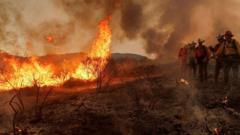With critical biodiversity at risk, experts warn of a volatile future for the Great Barrier Reef.
Great Barrier Reef Faces Unprecedented Coral Decline Amid Climate Crisis

Great Barrier Reef Faces Unprecedented Coral Decline Amid Climate Crisis
AIMS report reveals record annual decline in coral cover across Australia's iconic reef system.
The Great Barrier Reef has recorded its most severe annual decline in coral cover since monitoring began nearly 40 years ago, according to a report released by the Australian Institute of Marine Science (AIMS). The recent assessments show that both the northern and southern sections of this sprawling Australian reef have suffered from extensive coral bleaching, attributed primarily to climate change, despite additional stressors such as tropical cyclones and crown-of-thorns starfish infestations.
The AIMS survey, which examined the health of 124 coral reefs between August 2024 and May 2025, indicates that the reef system is close to reaching a critical tipping point where recovery may no longer be possible. The phenomenon of coral bleaching—a process that leads stressed coral to turn white—has been exacerbated by climate change, with record heat levels triggering this grave situation.
The Great Barrier Reef, often referred to as the largest living structure on Earth, spans over 2,300 kilometers and supports a rich biodiversity, harboring an estimated 25% of all marine species. Unfortunately, this year's data reveal widespread coral mortality, with the iconic structures turning white due to excessive heat stress—a trend observed in previous years as well.
The report indicates that the stress threshold for coral is precariously close, as even a mere 1 degree Celsius increase above their tolerance for extended periods can lead to massive die-offs. Past instances of significant coral bleaching have occurred sequentially, with 2024 marking the sixth occurrence since 2016 driven by unusually warm sea temperatures.
Environmental factors, including the El Niño phenomenon, have further complicated recovery efforts for the reefs, which have been marked by "unprecedented levels of heat stress." Given the projections for climate warming, the outlook remains grim unless immediate action is taken to reduce greenhouse gas emissions and improve local environmental conditions.
The most vulnerable coral species affected have been identified as Acropora, known for their rapid growth but also for being prime targets for the voracious crown-of-thorns starfish, whose population has surged since the 1960s, primarily due to nutrient run-off from agriculture.
While some conservation efforts, like the Australian government's culling program targeting crown-of-thorns starfish, have yielded positive outcomes—eliminating severe outbreaks in some areas—the overarching threat of climate change remains unaddressed. Experts like Richard Leck from WWF have expressed concerns regarding the reef's ability to recover as it endures relentless stress, highlighting that some global coral reefs are already beyond the threshold of restoration.
Despite its UNESCO heritage status and conservation endeavors, the Great Barrier Reef is increasingly seen as "in danger," necessitating urgent, impactful measures to combat the dual threats of warming seas and environmental pollution, in order to preserve this vital ecosystem for future generations.
The AIMS survey, which examined the health of 124 coral reefs between August 2024 and May 2025, indicates that the reef system is close to reaching a critical tipping point where recovery may no longer be possible. The phenomenon of coral bleaching—a process that leads stressed coral to turn white—has been exacerbated by climate change, with record heat levels triggering this grave situation.
The Great Barrier Reef, often referred to as the largest living structure on Earth, spans over 2,300 kilometers and supports a rich biodiversity, harboring an estimated 25% of all marine species. Unfortunately, this year's data reveal widespread coral mortality, with the iconic structures turning white due to excessive heat stress—a trend observed in previous years as well.
The report indicates that the stress threshold for coral is precariously close, as even a mere 1 degree Celsius increase above their tolerance for extended periods can lead to massive die-offs. Past instances of significant coral bleaching have occurred sequentially, with 2024 marking the sixth occurrence since 2016 driven by unusually warm sea temperatures.
Environmental factors, including the El Niño phenomenon, have further complicated recovery efforts for the reefs, which have been marked by "unprecedented levels of heat stress." Given the projections for climate warming, the outlook remains grim unless immediate action is taken to reduce greenhouse gas emissions and improve local environmental conditions.
The most vulnerable coral species affected have been identified as Acropora, known for their rapid growth but also for being prime targets for the voracious crown-of-thorns starfish, whose population has surged since the 1960s, primarily due to nutrient run-off from agriculture.
While some conservation efforts, like the Australian government's culling program targeting crown-of-thorns starfish, have yielded positive outcomes—eliminating severe outbreaks in some areas—the overarching threat of climate change remains unaddressed. Experts like Richard Leck from WWF have expressed concerns regarding the reef's ability to recover as it endures relentless stress, highlighting that some global coral reefs are already beyond the threshold of restoration.
Despite its UNESCO heritage status and conservation endeavors, the Great Barrier Reef is increasingly seen as "in danger," necessitating urgent, impactful measures to combat the dual threats of warming seas and environmental pollution, in order to preserve this vital ecosystem for future generations.





















